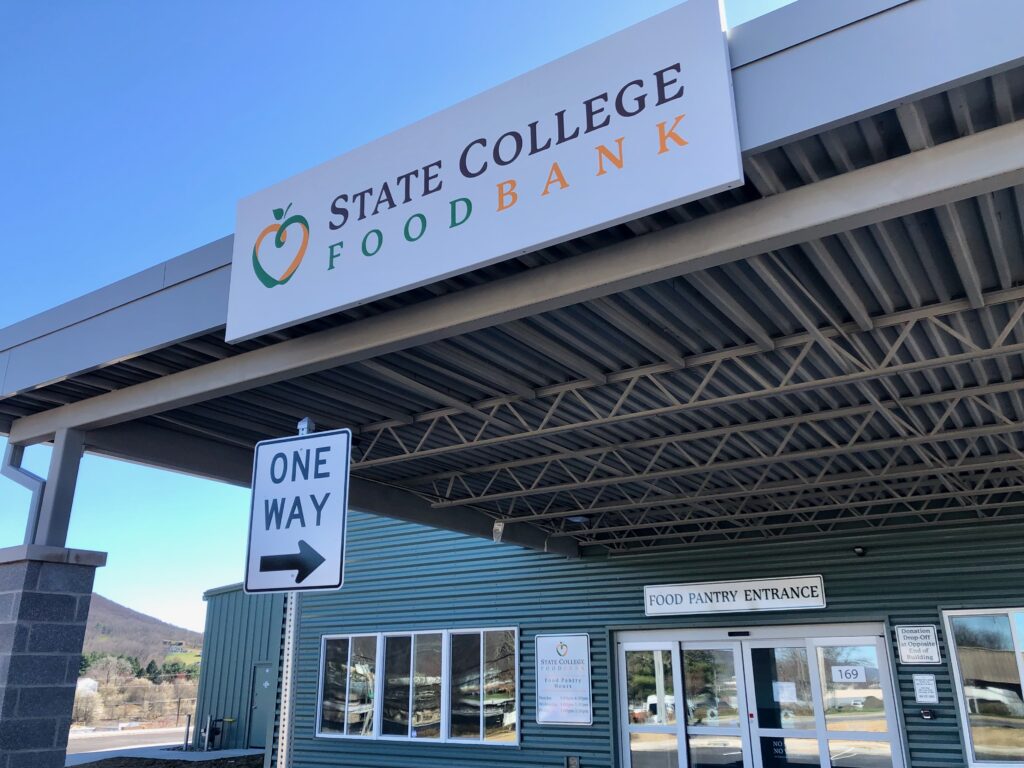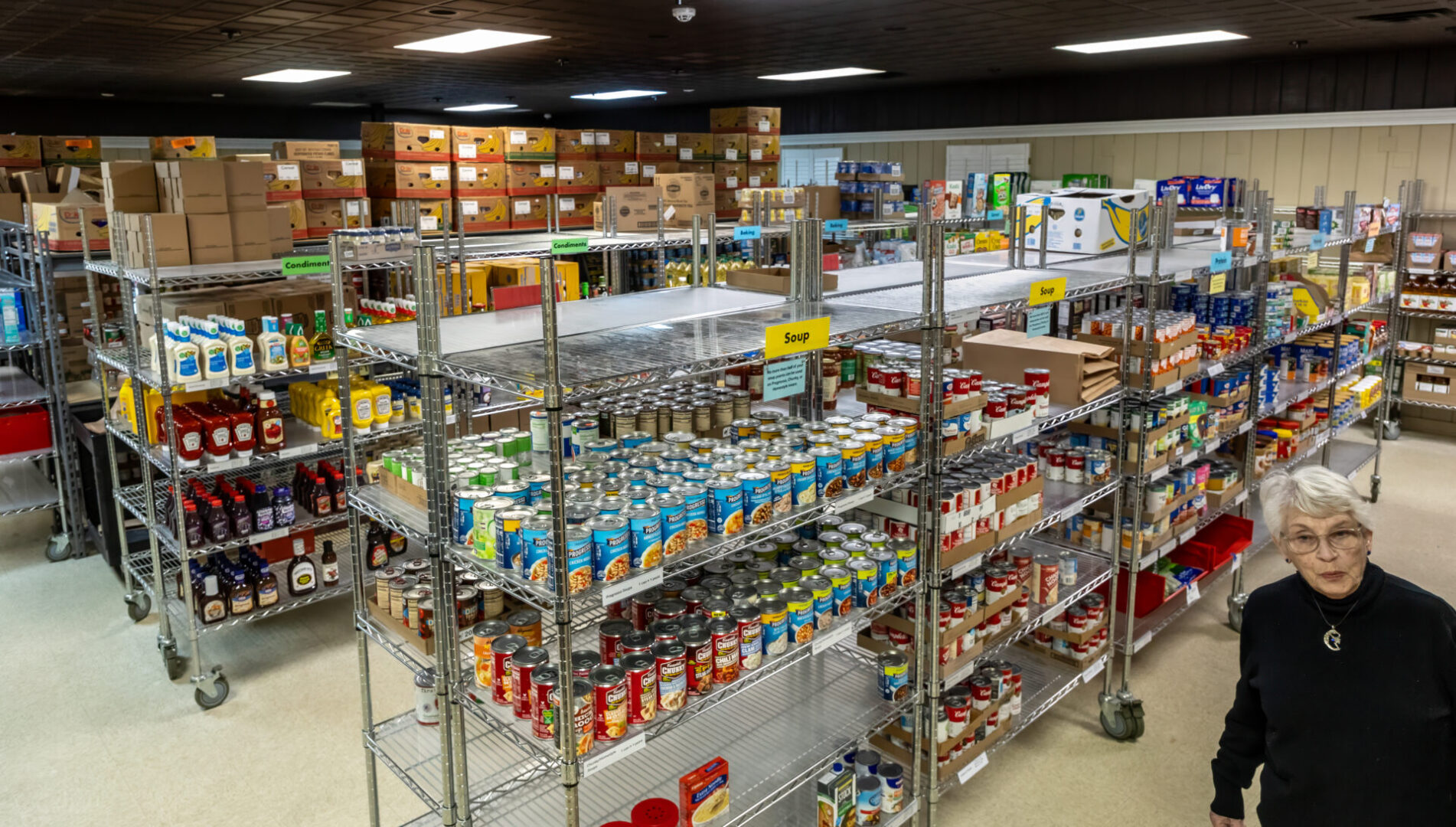In Happy Valley, it’s easy to overlook those Centre Countians who face food insecurity daily (15,520 of them, according to Feeding America). These neighbors often must choose between paying utility bills and putting meals on the table.
The Centre County United Way states that 15% of the 57,518 households in Centre County fall below the poverty level; another 31% are categorized as ALICE (asset limited, income constrained, employed) and aren’t eligible for federal aid. This is a growing population that—although often working multiple jobs—needs to turn to the State College Food Bank for assistance. And the numbers keep rising.
“I suffer from a chronic illness,” says Diana Spicer, “and need certain supplements to even get out of bed in the morning. It’s only because of the Food Bank that I can afford these—and so have the energy to care for our three children [ages nine, eight, and seven].
“My kids and I share a food issue,” she says. “We need to avoid gluten. The Food Bank provides us with things like gluten-free pasta—a favorite in our house—and flour. So I can make the kids a gluten-free treat for special events and they don’t feel left out. I hope one day my health will improve and I can rejoin the workforce, but currently, it’s hard to survive on one income. So for now, the Food Bank is a really significant help to our family.”
Last month, the State College Food Bank, which has been combating hunger since 1982, took a giant step toward fulfilling its mission for Centre County (“providing food security, directly or indirectly”) and its vision (“that one day, no one will go hungry”). Relocating from its old South Atherton Street location to a much larger site at 169 Gerald Street (off East College Avenue) made this leap possible.
“We can accomplish so much more with 18,000 square feet than we could with less than half that at the old building,” says Executive Director Allayn Beck. “We have seen a 77% increase in households served since 2021, which created many challenges including lines of people waiting in all weather, a lack of food-storage areas causing us to rent auxiliary space, and numerous procedural headaches. Consolidating locations under one roof facilitates efficient logistical and programmatic operations.”
The new Food Bank location has begun grocery distribution to clients, and it is currently accepting donations 9 a.m. to 4:30 p.m. on Mondays and 9 a.m. to 3:30 p.m. Wednesdays and Fridays.
“With a large loading dock,” says Dave Woodle, volunteer project manager for the renovation, “we can take in larger deliveries and redistribute some of that food to other feeding programs throughout Centre County. My wife, Hollie, and I first became involved with the Food Bank through our church. She’s been a volunteer for 10 years, and for the last three or four of those, we’ve been coming in together to restock shelves. I’ve also helped with strategic planning in the past, so I know that the staff and the board work hard at networking with local, state, and federal organizations to offer assistance beyond our own facility.”

Living paycheck to paycheck
Beck began working for the Food Bank seven years ago. “I’ve seen a wide range of situations and people—some who have been coming for years, others who come for a short while. But I have never come across anyone not truly in need. To receive food, clients must obtain a 12-month referral from a caseworker, typically through another social service provider. We believe if someone requires help with food, it’s very likely they could benefit from additional services. Working with a caseworker provides a holistic approach.
“Because of support from our local community, there are no income restrictions and we can serve anyone in need. For example, even if a household member is employed, many families live paycheck to paycheck. So an unexpected expense—an emergency-room visit, a child needing braces, or a critical home repair—can tip them into the poverty cycle. But having much of their food supplied at no cost helps people get back on track.
Beck says the Food Bank’s clients have varied circumstances. “Some clients live alone; some are couples; some are multi-generational families; and others live together but are unrelated. There’s also been a big increase in individuals and families coming to the Food Bank who are from other countries—including Ukrainian, Afghan, Guatemalan and Russian families—who have been so patient and understanding as we do our best to offer more culturally responsive foods.”
The Food Bank has been a “blessing” for Sultan Bilal. “I’m a single dad with a six-year-old daughter, and even though I have a maintenance job at night and work construction when I can, the money doesn’t go far. The Food Bank helps me feed my daughter healthy meals, and taking care of her is the most important thing in the world to me. Twice I’ve had an emergency situation and was given an extra bag of food to get us through. I don’t have a car, so they’ve even called an Uber to help me get our groceries home. That’s how friendly and supportive the people at the Food Bank are.
“Another thing they do,” says Bilal, “is provide people with information about finding other services. I appreciate the Food Bank so much. It makes a big difference to my daughter and me, and to so many others.”
‘A warm and welcoming place’
On Monday, Wednesday, and Friday afternoons, the Food Bank is set up much like a grocery store. Clients receive points (based on number of people in the household) to use at each station—meat and other protein, vegetables, dairy, fruit, bread, etc. A volunteer accompanies the shopper through the pantry. Once a month, each household leaves with around two weeks’ worth of groceries, and everything is delivered to their vehicle when they’re done shopping.
Operations Manager Virginia Meadows keeps an eye on the inventory of purchased and donated food. She also trains and oversees the volunteers. “We currently have around 100 volunteers,” she says, “about 80 who come in at least once a week, and others who help as needed. This wonderful group of people—some of whom have been volunteering for twenty years or more—make our Food Bank a warm and welcoming place.
“Almost all the local grocery stores donate things like fresh produce, frozen meat, dairy and bakery items and lots more. Two volunteers use our cargo van for those pickups; other morning volunteers restock the shelves, fill the refrigerator with milk and eggs, see the freezer contains ground beef, pork chops, etc., and make sure everything they put out is safe to consume. We work hard on accommodating personal preferences and special dietary needs too. And with the extra space at this new location, we can provide a wider variety of food. Some clients must choose gluten-free, dairy-free, low-salt, or low-sugar items. Others may be vegetarian or pescatarian, or have specific requests for religious reasons.”
Karen Parrish, a nine-year Food Bank volunteer, handles the meat station on Fridays. “If we get a cut of meat I’m not familiar with,” she says, “I’ll buy some myself and learn how to prepare it so I can share that information with clients. They come from all walks of life and just need a little help in getting through the month. And they’re so appreciative and mindful of others. I often hear someone say, ‘We don’t need that ground beef—or chicken or whatever—this time, so please give it to somebody else.’ One day a woman approaching my station told me she’d just lost her job and started to cry. She got a hug along with her protein.”
Like fellow staff members Beck and Meadows, Business Manager Heather Lee handles numerous responsibilities. One involves client intake; another, preparing monthly statistics reports. “Some days I’m blindsided by a client’s story and reminded how unfair life can be,” says Lee. “Other times I see things that make me smile. For example, at our old location last year, a little girl who’d been waiting in line for a long time started to cry. An elderly gentleman behind her caught the child’s eye, sang with her, and played ‘Itsy Bitsy Spider.’ Those two made a real connection, and Mom was able to focus on choosing her groceries. I’m often touched by the graciousness and concern toward others shown by the people we serve.”
Irvin Moore is a prime example of this. He volunteers with numerous local organizations, writes a blog encouraging others to “reach out and help someone every day,” and tirelessly advocates for currently and formerly incarcerated individuals to have access to education and treatment with dignity.
“When I first moved here,” says Moore, “I had nothing, so the Food Bank was invaluable. They asked if I had any dietary restrictions, and then ‘do you want meat, cheese, fresh vegetables, cereal, canned goods?’ The variety and amount of what they offer is astounding. These folks are open and engaging, and you can see in their eyes they really care—that they’re sincere and genuine. I needed their help beginning in June 2021. But I’m a strong and healthy old-timer at 77, and after a year, I was fortunate enough to get a job that allowed me to pay for groceries.”

Community support is key
Monetary and in-kind donations from the local community—including from individuals, the Centre County United Way, Centre Gives, numerous grocery stores and many other area groups and organizations—provide most of the State College Food Bank’s financial support and supplies, including about seventy percent of its food. The purchase of the new site and its renovation cost $4.3 million.
The “Fighting Hunger – Feeding Community – Building Hope” Capital Campaign (the first one since the Food Bank’s inception 41 years ago) and the sale of the old location brought in significant funds toward those costs. “But if we can raise enough additional money to avoid a mortgage,” says Board President Jens Thorsen, “every saved dollar can go toward further services for our neighbors in need.
“All of us at the Food Bank—our strong and talented staff, our fully engaged board members, and our remarkable volunteers—firmly believe that access to food is fundamental,” Thorsen says. “Because if a child is hungry, everything else falls apart. And adults without enough to eat find that life becomes much harder. With this expanded space, we’ll be able to reach many more people experiencing food insecurity throughout Centre County. This is why the State College Food Bank is one of our community’s most foundational resources.”
For more information about the State College Food Bank—including how to contribute—visit scfoodbank.org and/or follow State College Food Bank on Instagram or Facebook. T&G
Diane Johnston Leos is a State College freelance writer.



